Yu-Chuan Su
Alex
Inference-Time Scaling for Diffusion Models beyond Scaling Denoising Steps
Jan 16, 2025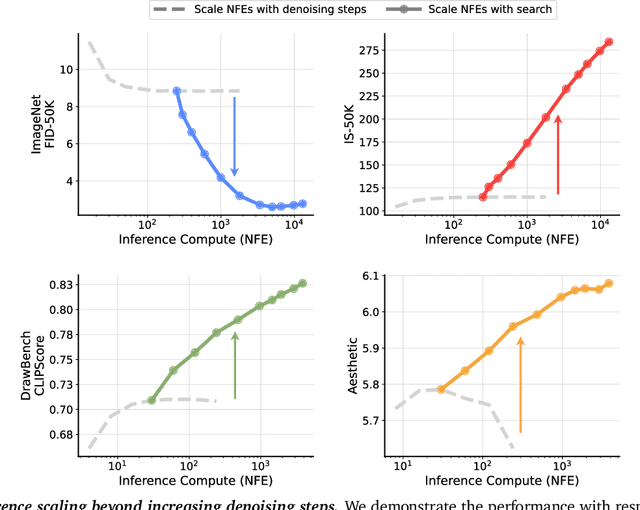


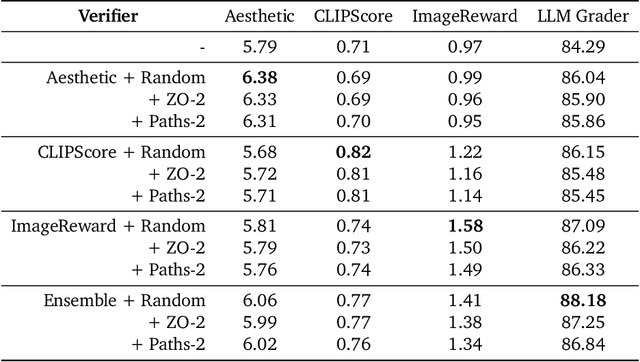
Abstract:Generative models have made significant impacts across various domains, largely due to their ability to scale during training by increasing data, computational resources, and model size, a phenomenon characterized by the scaling laws. Recent research has begun to explore inference-time scaling behavior in Large Language Models (LLMs), revealing how performance can further improve with additional computation during inference. Unlike LLMs, diffusion models inherently possess the flexibility to adjust inference-time computation via the number of denoising steps, although the performance gains typically flatten after a few dozen. In this work, we explore the inference-time scaling behavior of diffusion models beyond increasing denoising steps and investigate how the generation performance can further improve with increased computation. Specifically, we consider a search problem aimed at identifying better noises for the diffusion sampling process. We structure the design space along two axes: the verifiers used to provide feedback, and the algorithms used to find better noise candidates. Through extensive experiments on class-conditioned and text-conditioned image generation benchmarks, our findings reveal that increasing inference-time compute leads to substantial improvements in the quality of samples generated by diffusion models, and with the complicated nature of images, combinations of the components in the framework can be specifically chosen to conform with different application scenario.
KITTEN: A Knowledge-Intensive Evaluation of Image Generation on Visual Entities
Oct 15, 2024



Abstract:Recent advancements in text-to-image generation have significantly enhanced the quality of synthesized images. Despite this progress, evaluations predominantly focus on aesthetic appeal or alignment with text prompts. Consequently, there is limited understanding of whether these models can accurately represent a wide variety of realistic visual entities - a task requiring real-world knowledge. To address this gap, we propose a benchmark focused on evaluating Knowledge-InTensive image generaTion on real-world ENtities (i.e., KITTEN). Using KITTEN, we conduct a systematic study on the fidelity of entities in text-to-image generation models, focusing on their ability to generate a wide range of real-world visual entities, such as landmark buildings, aircraft, plants, and animals. We evaluate the latest text-to-image models and retrieval-augmented customization models using both automatic metrics and carefully-designed human evaluations, with an emphasis on the fidelity of entities in the generated images. Our findings reveal that even the most advanced text-to-image models often fail to generate entities with accurate visual details. Although retrieval-augmented models can enhance the fidelity of entity by incorporating reference images during testing, they often over-rely on these references and struggle to produce novel configurations of the entity as requested in creative text prompts.
Imagen 3
Aug 13, 2024Abstract:We introduce Imagen 3, a latent diffusion model that generates high quality images from text prompts. We describe our quality and responsibility evaluations. Imagen 3 is preferred over other state-of-the-art (SOTA) models at the time of evaluation. In addition, we discuss issues around safety and representation, as well as methods we used to minimize the potential harm of our models.
A Versatile Diffusion Transformer with Mixture of Noise Levels for Audiovisual Generation
May 22, 2024



Abstract:Training diffusion models for audiovisual sequences allows for a range of generation tasks by learning conditional distributions of various input-output combinations of the two modalities. Nevertheless, this strategy often requires training a separate model for each task which is expensive. Here, we propose a novel training approach to effectively learn arbitrary conditional distributions in the audiovisual space.Our key contribution lies in how we parameterize the diffusion timestep in the forward diffusion process. Instead of the standard fixed diffusion timestep, we propose applying variable diffusion timesteps across the temporal dimension and across modalities of the inputs. This formulation offers flexibility to introduce variable noise levels for various portions of the input, hence the term mixture of noise levels. We propose a transformer-based audiovisual latent diffusion model and show that it can be trained in a task-agnostic fashion using our approach to enable a variety of audiovisual generation tasks at inference time. Experiments demonstrate the versatility of our method in tackling cross-modal and multimodal interpolation tasks in the audiovisual space. Notably, our proposed approach surpasses baselines in generating temporally and perceptually consistent samples conditioned on the input. Project page: avdit2024.github.io
Instruct-Imagen: Image Generation with Multi-modal Instruction
Jan 03, 2024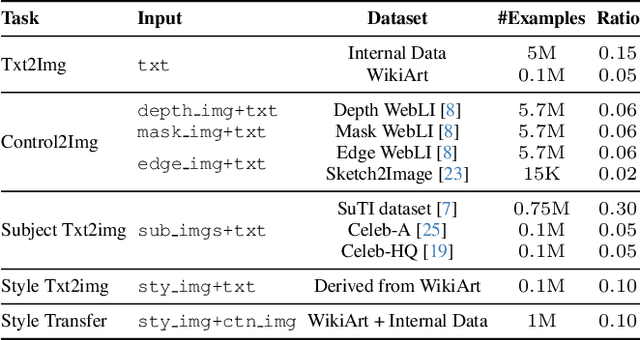
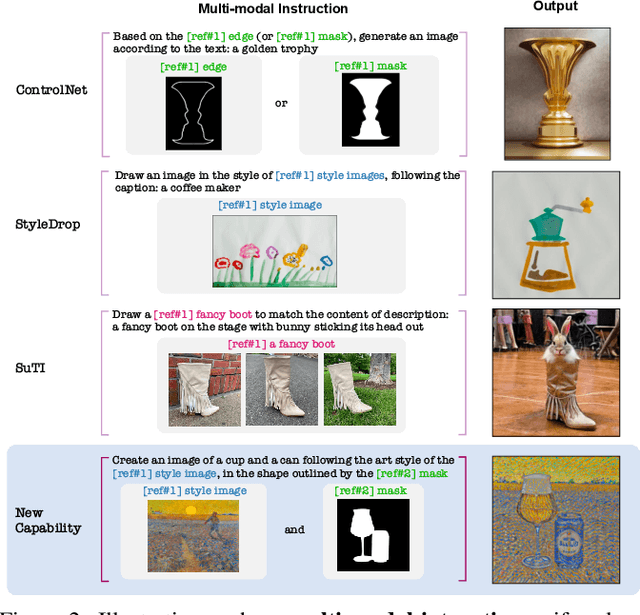

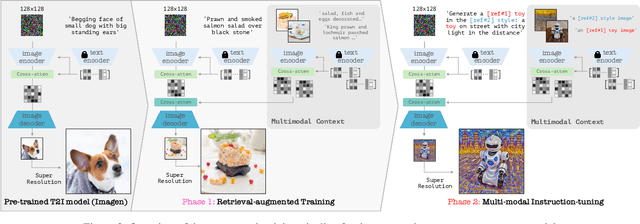
Abstract:This paper presents instruct-imagen, a model that tackles heterogeneous image generation tasks and generalizes across unseen tasks. We introduce *multi-modal instruction* for image generation, a task representation articulating a range of generation intents with precision. It uses natural language to amalgamate disparate modalities (e.g., text, edge, style, subject, etc.), such that abundant generation intents can be standardized in a uniform format. We then build instruct-imagen by fine-tuning a pre-trained text-to-image diffusion model with a two-stage framework. First, we adapt the model using the retrieval-augmented training, to enhance model's capabilities to ground its generation on external multimodal context. Subsequently, we fine-tune the adapted model on diverse image generation tasks that requires vision-language understanding (e.g., subject-driven generation, etc.), each paired with a multi-modal instruction encapsulating the task's essence. Human evaluation on various image generation datasets reveals that instruct-imagen matches or surpasses prior task-specific models in-domain and demonstrates promising generalization to unseen and more complex tasks.
Fine-grained Controllable Video Generation via Object Appearance and Context
Dec 05, 2023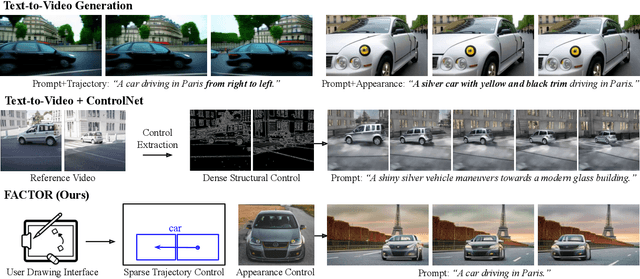
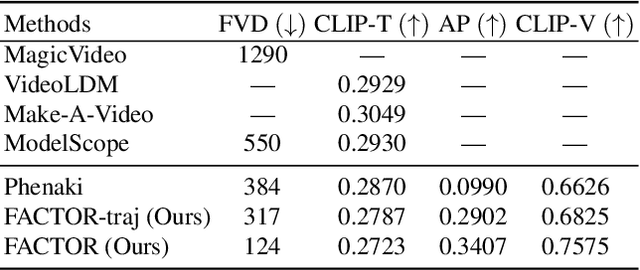


Abstract:Text-to-video generation has shown promising results. However, by taking only natural languages as input, users often face difficulties in providing detailed information to precisely control the model's output. In this work, we propose fine-grained controllable video generation (FACTOR) to achieve detailed control. Specifically, FACTOR aims to control objects' appearances and context, including their location and category, in conjunction with the text prompt. To achieve detailed control, we propose a unified framework to jointly inject control signals into the existing text-to-video model. Our model consists of a joint encoder and adaptive cross-attention layers. By optimizing the encoder and the inserted layer, we adapt the model to generate videos that are aligned with both text prompts and fine-grained control. Compared to existing methods relying on dense control signals such as edge maps, we provide a more intuitive and user-friendly interface to allow object-level fine-grained control. Our method achieves controllability of object appearances without finetuning, which reduces the per-subject optimization efforts for the users. Extensive experiments on standard benchmark datasets and user-provided inputs validate that our model obtains a 70% improvement in controllability metrics over competitive baselines.
Towards Authentic Face Restoration with Iterative Diffusion Models and Beyond
Jul 18, 2023



Abstract:An authentic face restoration system is becoming increasingly demanding in many computer vision applications, e.g., image enhancement, video communication, and taking portrait. Most of the advanced face restoration models can recover high-quality faces from low-quality ones but usually fail to faithfully generate realistic and high-frequency details that are favored by users. To achieve authentic restoration, we propose $\textbf{IDM}$, an $\textbf{I}$teratively learned face restoration system based on denoising $\textbf{D}$iffusion $\textbf{M}$odels (DDMs). We define the criterion of an authentic face restoration system, and argue that denoising diffusion models are naturally endowed with this property from two aspects: intrinsic iterative refinement and extrinsic iterative enhancement. Intrinsic learning can preserve the content well and gradually refine the high-quality details, while extrinsic enhancement helps clean the data and improve the restoration task one step further. We demonstrate superior performance on blind face restoration tasks. Beyond restoration, we find the authentically cleaned data by the proposed restoration system is also helpful to image generation tasks in terms of training stabilization and sample quality. Without modifying the models, we achieve better quality than state-of-the-art on FFHQ and ImageNet generation using either GANs or diffusion models.
Controllable One-Shot Face Video Synthesis With Semantic Aware Prior
Apr 27, 2023Abstract:The one-shot talking-head synthesis task aims to animate a source image to another pose and expression, which is dictated by a driving frame. Recent methods rely on warping the appearance feature extracted from the source, by using motion fields estimated from the sparse keypoints, that are learned in an unsupervised manner. Due to their lightweight formulation, they are suitable for video conferencing with reduced bandwidth. However, based on our study, current methods suffer from two major limitations: 1) unsatisfactory generation quality in the case of large head poses and the existence of observable pose misalignment between the source and the first frame in driving videos. 2) fail to capture fine yet critical face motion details due to the lack of semantic understanding and appropriate face geometry regularization. To address these shortcomings, we propose a novel method that leverages the rich face prior information, the proposed model can generate face videos with improved semantic consistency (improve baseline by $7\%$ in average keypoint distance) and expression-preserving (outperform baseline by $15 \%$ in average emotion embedding distance) under equivalent bandwidth. Additionally, incorporating such prior information provides us with a convenient interface to achieve highly controllable generation in terms of both pose and expression.
Video Generation Beyond a Single Clip
Apr 15, 2023Abstract:We tackle the long video generation problem, i.e.~generating videos beyond the output length of video generation models. Due to the computation resource constraints, video generation models can only generate video clips that are relatively short compared with the length of real videos. Existing works apply a sliding window approach to generate long videos at inference time, which is often limited to generating recurrent events or homogeneous content. To generate long videos covering diverse content and multiple events, we propose to use additional guidance to control the video generation process. We further present a two-stage approach to the problem, which allows us to utilize existing video generation models to generate high-quality videos within a small time window while modeling the video holistically based on the input guidance. The proposed approach is complementary to existing efforts on video generation, which focus on generating realistic video within a fixed time window. Extensive experiments on challenging real-world videos validate the benefit of the proposed method, which improves over state-of-the-art by up to 9.5% in objective metrics and is preferred by users more than 80% of time.
Identity Encoder for Personalized Diffusion
Apr 14, 2023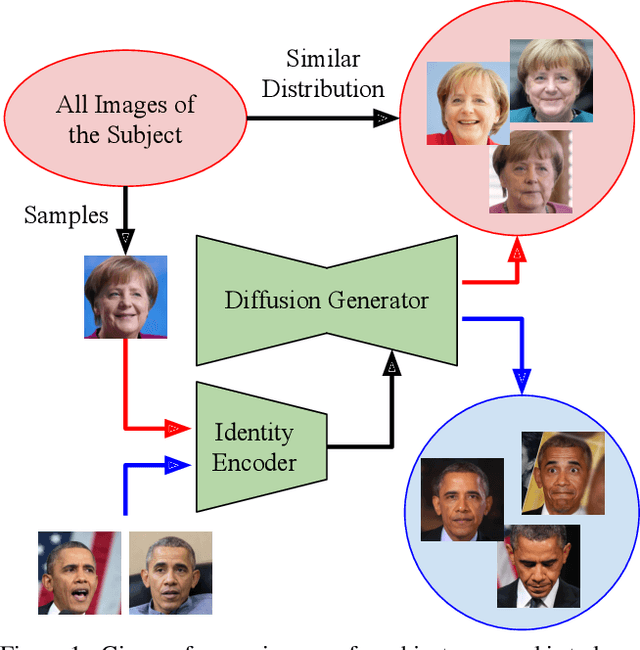

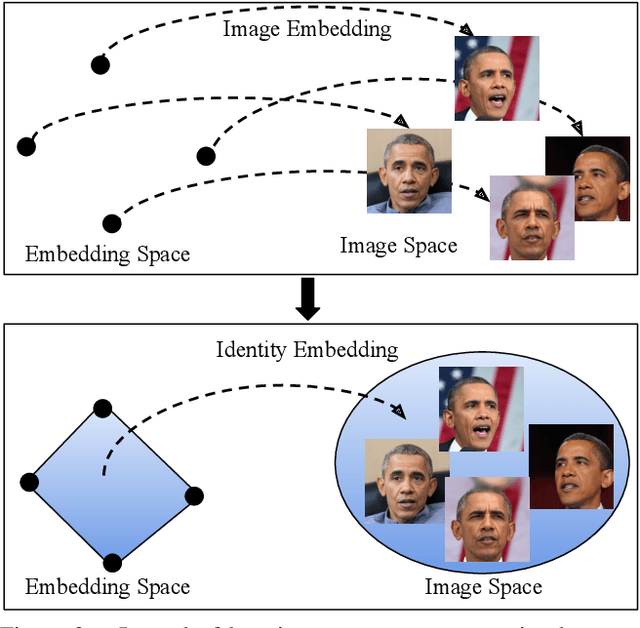

Abstract:Many applications can benefit from personalized image generation models, including image enhancement, video conferences, just to name a few. Existing works achieved personalization by fine-tuning one model for each person. While being successful, this approach incurs additional computation and storage overhead for each new identity. Furthermore, it usually expects tens or hundreds of examples per identity to achieve the best performance. To overcome these challenges, we propose an encoder-based approach for personalization. We learn an identity encoder which can extract an identity representation from a set of reference images of a subject, together with a diffusion generator that can generate new images of the subject conditioned on the identity representation. Once being trained, the model can be used to generate images of arbitrary identities given a few examples even if the model hasn't been trained on the identity. Our approach greatly reduces the overhead for personalized image generation and is more applicable in many potential applications. Empirical results show that our approach consistently outperforms existing fine-tuning based approach in both image generation and reconstruction, and the outputs is preferred by users more than 95% of the time compared with the best performing baseline.
 Add to Chrome
Add to Chrome Add to Firefox
Add to Firefox Add to Edge
Add to Edge